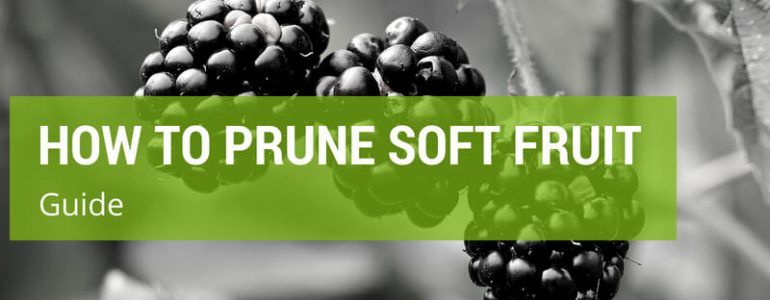Naturally, you want your soft fruit vines and bushes to be as productive as possible. Proper pruning is an important aspect of supporting and encouraging optimum fruit production. In this article, we present the best practices in pruning your soft fruit producers for the greatest yield. Read on to learn more.
How To Prune Soft Fruit
1. How to prune Blackberries, Loganberries and Tayberries
For all three of these types of soft fruit bushes, new canes are produced in one season and then fruit is produced on this old growth the following season. Pruning consists mainly of removing exhausted canes after fruiting is complete. This can be a confusing prospect because on a single bush you will see old growth with fruit and new growth without fruit.
For good pruning, trim back the canes with fruit at ground level. Move the new growth to the support wires you have emptied. If the new canes are lacking in number, take care to keep some of the better examples amongst the older canes. Check them for side-shoots and clip these back leaving only a single leaf.
2. How to prune Raspberries
Raspberries that fruit in the summertime are very similar to blackberries. They fruit on old canes which should be removed after harvest. This leaves room for young, new canes to thrive.
If you have autumn-fruiting raspberries, you should simply cut them back all the way to the ground late in the winter. This will clear the way for new canes to emerge in the spring. These will fruit during the first year.
3. How to prune Black Currants
If you want your black currant bushes to do well, you must be very diligent about pruning. Even though older branches left in place will fruit, the quality and the quantity of the fruit diminishes with the passage of time.
New bushes must be deeply planted to encourage the root ball to produce lots of vigorous new branches underground. The new branches will emerge to replace older, spent branches, which should be removed after you harvest the currants.
Every year you should prune back approximately a third of the older stems. Look for bark that is very dark brown or even black. These should be removed because this coloration means that they are quite weak. Cut them all the way back to the ground, being careful not to accidentally remove vibrant, new shoots.
It is fine to prune these old stems back when you harvest the currants, or you can wait until the growing season is completely over and do your pruning in the winter months. This practice eliminates the worry of accidentally damaging new shoots in the process.
4. How to prune Gooseberries
If you don’t prune your gooseberry bushes, they will become a tangled mess. For proper management, you must keep the center of each bush open to the sunlight and air. Just leave a handful of main branches, spaced at regular intervals around the perimeter of the bush.
In wintertime, perform a thorough pruning to remove diseased or dead stems. Any stems growing across the center of the bush should also be trimmed back leaving only a young shoot. Prune off any drooping stems and thin out any overcrowded areas of your bushes. Leave only selected, upright side-shoots. New growth should be trimmed back by half to control size.
5. How to prune Grape Vines
Grapevines love to climb, and if you allow them to run rampant, they will put all their energy into climbing. Pruning and training are very important in redirecting your grapevines to focus on fruiting. To do this, you should select a few hardy, permanent stems and allow fruiting side-shoots to arise from these during the growing season each year.
In the middle of the winter, cut back some of the side-shoots to leave only one or two buds. Trim back established main stems to just one, individual new bud. If there are newer stems you wish to develop, allow them a couple of buds.
In summertime shorten lateral stems that are not in flower. Leave no more than five side-shoots growing from each of these back to only a single leaf. Lateral stems that are in bloom should be trimmed back to a pair of leaves just past the initial truss. Remove all superlative trusses.
6. How to prune Strawberries
You don’t absolutely have to prune strawberries annually; however, they do produce lots of runners. If these are allowed to run amok, they will drain the plant’s energy without increasing its yield.
Of course, if you want to propagate strawberry plants, runners should be encouraged, but if you want to improve the productivity of your existing plants, you should prune them away.
Proper management of your soft fruiting vines and bushes is the best way to keep a close eye on the condition of your plants. Good pruning tools help prevent disease and encourage abundant fruit. Follow the tips presented here to improve fruiting and maintain healthy plants.

![Best Pruning Saw [Buying Guide + Reviews] Best Pruning Saw [Buying Guide + Reviews]](https://www.gardendad.co.uk/wp-content/uploads/2018/01/best-pruning-saw-70x70.jpg)






How do you prune the new thornless raspberry types?
It depends if they are autumn or summer fruiting – some produce fruit on 2 year old wood and some on new wood. If you look at wikihow- how to prune raspberries,
It gives a really good explanation about the whole
Process, however you would still need to know which category your thornless cultivars fall into. Good luck.